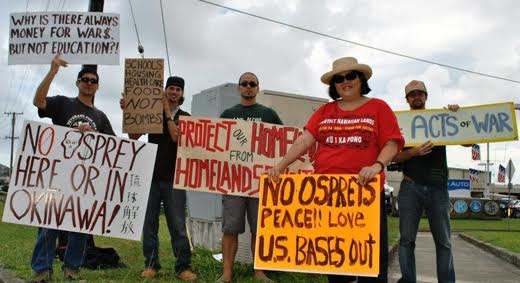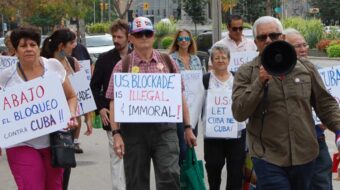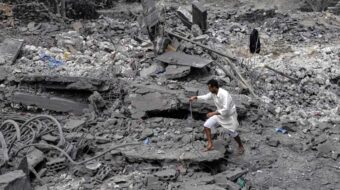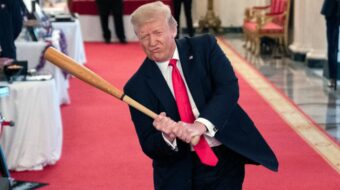
Days of infamy: Invasion and overthrow
The upper chamber of the Japanese parliament’s Sept. 19 decision to “reinterpret” Article 9 of the country’s pacifistic constitution to allow Tokyo’s so-called “Self-Defense Forces” to participate in combat overseas for the first time since World War II is eyebrow-raising if not hair-raising. Ironically, it comes almost exactly 75 years to the day of the Tripartite Pact, when Imperial Japan joined the Berlin-Rome Axis, the alliance of Hitler’s Nazis and Mussolini’s fascists, on Sept. 27, 1940.
The pact helped set the stage for the Japanese attack on the U.S. territories of Hawaii, Guam, the Philippines and elsewhere, engulfing America in WWII. President Roosevelt called the Dec. 7, 1941 imperial Japanese bombing of Pearl Harbor “a date which will live in infamy.” But for Hawaiian nationalists the realpolitik pitting Washington against Tokyo is a case study in how Pacific islands are used as pawns, caught in the crossfire of superpowers. The U.S.-backed coup and invasion almost half a century earlier are also days of infamy.
Recently, I interviewed three longtime Hawaii activists on the role and impact of the U.S. armed forces in Hawaii, including the environmental devastation this century-plus long occupation has wrought on the isles’ fragile ecosystems.
Dennis “Bumpy” Kanahele is the leader of the pro-independence Nation of Hawaii. In the recent Cameron Crowe movie “Aloha” he co-stars with Bradley Cooper, Emma Stone and Rachel MacAdams, playing a version of himself called Dennis “Bumpy” Kanahele, the head of a liberated village of Hawaiians, that was shot, in part, at the actual site in Waimanalo, Oahu, where such a community actually exists, led by Kanahele. In the feature film, which has an anti-nuclear, anti-weaponization of outer space theme, Kanahele wears a T-shirt proclaiming on the front “Hawaiian By Birth” and “American By Force” on the back.
I also interviewed human rights activist attorney Hayden Burgess, whose Hawaiian name is Poka Laenui. Unlike Kanahele and Laenui, peace campaigner Jim Albertini is a haole (Caucasian), who has lived in Hawaii for decades. President of the Big Island-based Malu ‘Aina Center for Non-violent Education and Action, Albertini co-authored the 1980 book “The Dark Side of Paradise, Hawaii in a Nuclear World.”
Laenui believes U.S. militarism “was actually the second wave of an insertion of American colonization into Hawaii” after the Christian missionaries. Washington’s military interest in Hawaii goes back to at least 1872, when Major General John Schofield was dispatched to Hawaii “as a scout. He was casing out the area, doing recon at strategic areas, such as Pearl Harbor,” states Kanahele. Laenui adds that Schofield and Brevet Brigadier Gen. B.S. Alexander went to Hawaii “under the pretense of coming as tourists…. They came here as spies to determine the military possibilities of using Hawaii so that in the future the U.S. could reach farther out in their [forward] basing strategy to continually expand the American empire into the Pacific and Asia. It was part of the general trend of American expansionism, following the theory of ‘manifest destiny'” beyond the West Coast, eventually aiming at turning the Pacific into an “American lake.”
Schofield and Alexander reported back to the high command that with Oceania’s largest anchorage, Pearl Harbor would be an excellent place for a Navy base. Laenui notes that a contentious 1887 Treaty of Reciprocity ceded Pearl Harbor to the U.S., giving sugar planters (mostly descended from the original American missionaries) duty free access to the American market. The proverbial camel’s nose was under the tent – with Hawaii about to get humped.
Kanahele unambiguously calls the American armed forces’ actions during the 1893 overthrow of the independent, internationally-recognized Kingdom of Hawaii “an act of war. The role of the U.S. military was to support the Committee of Public Safety at that time. Basically, the U.S. military pointed the cannons on the gunship directly at Iolani Palace,” the seat of Polynesian power located in downtown Honolulu where Queen Liliuokalani – who was attempting to promulgate a new constitution enhancing indigenous rights and control – resided. “They invaded Hawaii,” Kanahele asserts.
Laenui explains that plantation owners and businessmen largely descended from the missionaries colluded with U.S. Minister Plenipotentiary John Stevens, who “landed 162 Blue-jackets from the [steel warship] USS Boston at Honolulu Harbor, near Hawaii’s center of business and politics. They landed with the howitzer cannon and the Gatling gun and marched up Honolulu’s main street, King Street, that faces Iolani Palace, our national capitol. There they performed military exercises…and were stationed at the opera house…. The next day the Committee of Public Safety [arrived nearby]…, read a proclamation declaring they were now the ‘provisional government’ of Hawaii and demanded that Queen Liliuokalani surrender.” There were 18 people on the Committee, mostly white missionary-descended planters/businessmen. After Her Majesty refused, “the U.S. military surrounded these 18 members and John Stevens assured he’d protect and defend these Americans, and also recognized the provisional government as Hawaii’s official government,” Laenui recounts.
To make a long, complicated story short, this led to Hawaii’s annexation during the Spanish-American War period – when voracious, rapacious Washington also grabbed the Philippines, Guam, Puerto Rico, etc. – and eventually to statehood in 1959.
Imperial occupation/indigenous landlessness and homelessness
What is the Pentagon’s presence in the so-called “Aloha State” today? Annexation resulted in “All of the public lands of the Hawaiian government and that belonged to the crown went to the U.S…. Today, most of the U.S. military” is on these so-called ‘ceded lands,'” Laenui points out. The Pentagon’s largest command post, the U.S. Pacific Command, is now headquartered at Camp H.M. Smith near Naval Station Pearl Harbor, where the U.S. Pacific Fleet is HQed. USPACOM’s area of jurisdiction covers more than 50 percent of the surface of the globe, 100 million-plus square miles, including the Pacific and Indian Ocean regions.
According to Albertini, DoD’s “major concentration is on Oahu, where there are over 100 separate military installations…about 25 percent of Oahu…. Expansion has been on the Big Island at the Pohakuloa Training Area…now 133,000 acres. Most of that land is not purchased by the military; it’s simply seized under presidential executive order or a state lease.” Statewide, the Pentagon controls more than a quarter million acres – or, according to “The Dark Side of Paradise,” 6 percent-plus of the land mass of America’s third smallest state, “more acreage [for the military than in] than 36 of the 49 mainland states. By percentage, Hawaii is the most militarized state in the nation…. The Pentagon has property on all the islands except those…privately owned.”
Asked who is actually on more of Hawaii’s land – Hawaiians or the DoD – Kanahele laughs: “The military, of course.” The DoD controls more than 10 percent of the 1.8 million acres of so-called Ceded Lands, exceeding the approximately 200,000 acres set aside for Natives through the Department of Hawaiian Home Lands. Hawaiians have not only been transformed into a landless minority in their ancient homeland, but homelessness is widespread, affecting Natives and other locals, too. “The military occupies not only so much land, contributing to our homelessness, but the land they got is prime, prime land. Places where Hawaiians used to fish, farm, do a lot of our subsistence living. Remember: With agriculture comes water…which plays a big part.”
In addition to on-base barracks and residences, military families compete with locals for off-base housing. Laenui laments, “More and more of our people become homeless because of the grab for limited resources and housing, and our people, who are the homeless, will have to leave Hawaii because it’s so expensive…. The military shoots up housing costs,” and pays little if any lease fees and taxes on DoD-controlled land, while the state government must use unreimbursed taxpayer money to educate dependents of armed services personnel, who number in the tens of thousands. More people of Hawaiian ancestry now live in the continental U.S. than in hyper-inflated Hawaii. Kanahele says that along with tourism, militarism is one of the 50th State’s two economic mainstays.
Making the world and islands safe for imperialism
“Hawaii has always been a military strategic point for invasions,” maintains Kanahele. The Defense Department has put its massive Hawaii presence to frequent use, as an integral part of its forward basing posture enabling U.S. imperialism to project power in the vast region under the USPACOM purview, stretching from West Coast USA to India, from North to South Pole. Of course, the Pearl Harbor sneak attack triggered U.S. entry into WWII, and since then “the air war in Vietnam was commanded from Hickam Air Force Base,” says Albertini, adding that Hawaii played an integral role in the Iraq Wars.
“As time goes by we realize more who the real decision makers are,” Kanahele muses. “The military’s role in Hawaii is to pull the trigger. Anytime something happens that has to do with Hawaii itself, now that the national sovereignty movement is picking up pace again – it’s under the guise of threats from outside forces. It’s still a U.S. military occupation of Hawaii…. The military plays an important role, because it’s the muscle.”
Regarding Defense Department land ownership in Hawaii, Kanahele asserts: “I don’t know about ‘owning’ land. They do have long term leases for free, for $1. It’s an occupation…. The U.S. military presence is here to keep us in order.”
Resistance
Hawaiian nationalists have had direct confrontations with the military. Starting in 1976 a series of Native occupations of Kahoolawe – an isle near Maui which Uncle Sam used for target practice since the 1940s – pitted activists against the Navy, eventually forcing them to stop the bombing there in the early 1990s. Kanahele adds that during a protest at Oahu’s Bellows Air Force Station, “some of our family went there, they stepped in front of military vehicles to make a point about training and exercises.” (In May two Marines died and 20 were injured after an Osprey crashed at Bellows during a training mission.)
Kanahele adds that Nation of Hawaii militants have disrupted missile launching at the Pacific Missile Range Facility Barking Sands, a Kauai installation for training and testing programs such as anti-ballistic missiles. “We’ve gone on the offense with the military, peacefully, nonviolently,” says Kanahele.
Health and environmental concerns
The massive Pentagon presence in Hawaii has allegedly come at a huge cost. Does the DoD have weapons of mass destruction in Hawaii? “It definitely does,” Kanahele declares. “It’s been a terrible impact,” insists Albertini, whose 1970s/1980s research “indicated there were 3000-plus nuclear weapons at Oahu, with West Loch Pearl Harbor being the main storage depot…. Pearl Harbor is a major Superfund site with major contamination…. Huge fuel tanks at Red Hill are leaking now, threatening to contaminate the groundwater of Oahu, which has a population of 1 million…. There’s unexploded ordinance all over the islands…[sometimes] with no signage or fences and housing complexes being built on military lands with serious contamination issues…. [Near] Kona, a World War II bombing range’s expected cleanup cost is $760 million,” claims the veteran peace organizer.
According to Laenui, in the Waianae area are “extremely tall towers, Oahu’s largest manmade structures, which broadcast extra-low frequency waves said to communicate with submarines half way around the world….” Radiofrequency radiation from the towers has been suspected of causing cancer and a leukemia cluster at Lualualei, but this has not been proven to be the case. Laenui suspects nuclear and/or chemical weapons are stored in bunkers there, but the secretive Pentagon (which has much to hide) neither confirms or denies nukes. “This Lualualei Valley was regarded as the first of Superfund sites…. Of course, Pearl Harbor was not very far behind. It goes to show the abuse of weapons to store and even bomb lands without appropriate cleanup,” says Laenui.
Live fire training continues at the Big Island’s Pohakuloa and Oahu’s Schofield Barracks and Kaneohe Marine Corps Air Station, says Albertini, adding: “There’s confirmed radiation contamination at both Schofield and Pohakuloa and likely at [Oahu’s] Makua Valley…. Depleted uranium was used as part of the training of the Davy Crockett nuclear weapon launcher system…. Today there are literally dozens of weapons systems that use DU.”
Johnston Atoll, located 700 miles south of Hawaii, was a nuclear test site from 1958-1963. A 1962 atmospheric thermonuclear blast produced a fireball visible in Honolulu, where it knocked out traffic lights. Years later chemical weapons were incinerated on an industrial level at Johnston.
From republic to empire
Once the indigenous people of the continental U.S. were conquered, “Manifest Destiny” began expanding overseas. By the 1890s Washington trained its sights on the Hawaiian Islands. The U.S.-backed overthrow of the independent Kingdom of Hawaii, followed by the annexation of what became the Territory of Hawaii, not only marked the extinguishment of sovereignty for the Native people. It also meant America’s transition from being a republic to becoming an empire with global imperial ambitions. These colonial, expansionist aspirations were not only carried out by the U.S. military but often perpetrated in order to secure foreign bases for the American armed forces as part of a forward basing policy to enable Washington to project its power worldwide.
Among other things, Kanahele envisions the decolonization of Hawaii as a way to solve landlessness and homelessness. “We’re airing out all the bad history and it’s not good for America when you look at the past. But how they could actually straighten out the mess is even a blessing in disguise. As they withdraw their forces places will be available” for sheltering those living on the beaches and streets at what had been Pentagon bases and buildings. “It falls in line with the restoration of the Hawaiian government,” adds the independence advocate.
Albertini states, “Hawaii is part of full spectrum dominance, air, land, sea and space, it has every aspect of militarism – and we want to demilitarize the islands.” Kanahele, co-star of the anti-weaponization and nuclearization of outer space movie Aloha, declares: “National sovereignty, our identity as Hawaiians, and our control over our lands is still on the line…. I believe the U.S. is eventually going to leave. It’s not like we want them here.”
The Japanese move to remilitarization, along with America’s ongoing armed occupation of Hawaii, threaten the lives and well-being of indigenous people and other locals for whom the islands are home – not forward bases for projecting imperial power.
Photo: Protest against militarization in Hawaii. Hawaii Peace and Justice. [The Osprey is a U.S. tiltrotor military aircraft. Since entering service with the U.S. Marine Corps and Air Force, the Osprey has been deployed in Iraq, Afghanistan, Libya and Kuwait.]
Ed Rampell lived in Tahiti, Samoa, Micronesia and Hawaii for 23 years reporting for AP, Honolulu Weekly, Radio Australia, Radio New Zealand, ABC News’ “20/20,” etc., on the Hawaiian Sovereignty and Nuclear Free and Independent Pacific movements. Rampell co-authored 2001’s “Pearl Harbor in the Movies” and the new book he co-authored is “The Hawaii Movie and Television Book” (see: http://hawaiimtvbook.weebly.com/).











